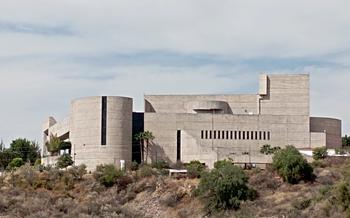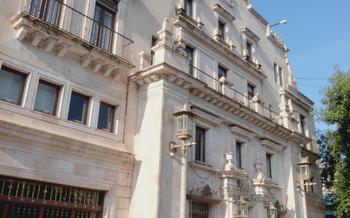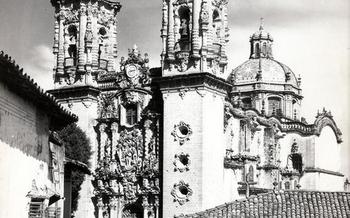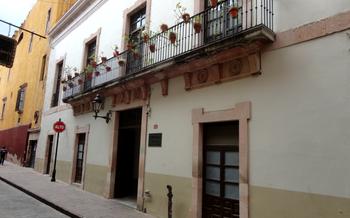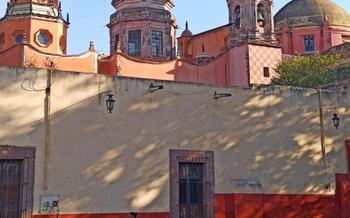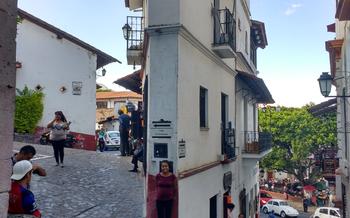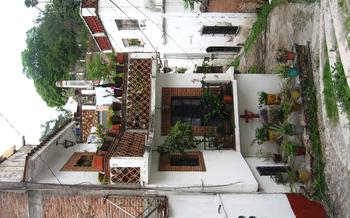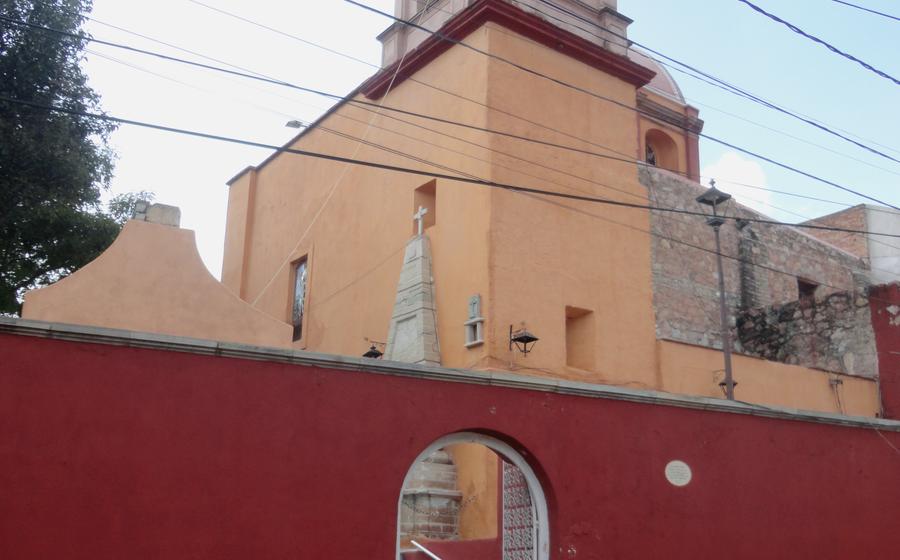
Templo de San Sebastián
- Templo de San Sebastián: A Baroque Masterpiece in Guanajuato
- Location and Accessibility
- History and Background
- Exterior Architecture
- Religious Significance
- Visiting Information
- Highlights for Visitors
- Nearby Attractions
- Shopping and Dining Options
- Accessibility and Accommodations
- Insider Tip: Hidden Gems and Lesser-Known Spots
Templo de San Sebastián: A Baroque Masterpiece in Guanajuato
In the heart of Guanajuato, Mexico, stands the Templo de San Sebastián, a testament to the city's rich history and vibrant culture. This magnificent Baroque masterpiece is not just a religious edifice but also an architectural wonder that attracts visitors from around the world. Embark on a journey through time as we explore the historical significance, architectural features, interior decorations, and cultural importance of this iconic landmark.
Historical Significance: Built in the 18th century, the Templo de San Sebastián holds a prominent place in Guanajuato's history. It was constructed during the city's mining boom, a period of great wealth and prosperity. The church served as a spiritual center for the miners, providing solace and comfort amidst the dangers and hardships of their work. Over the centuries, the temple has witnessed countless events, celebrations, and transformations, becoming an integral part of the city's identity.
Architectural Features: The Templo de San Sebastián showcases a remarkable blend of Baroque and Neoclassical architectural styles. Its imposing facade features intricate stone carvings, sculptures of saints and angels, and a grand entrance that invites visitors into its sacred space. The twin bell towers, crowned with elegant domes, soar above the city skyline, creating a striking visual landmark. The use of pink sandstone in its construction adds a warm and inviting glow to the temple, making it a true architectural masterpiece.
Interior Decorations: Step inside the Templo de San Sebastián, and you'll be captivated by its opulent interior. The walls and ceilings are adorned with intricate frescoes, murals, and paintings, depicting biblical scenes and the lives of saints. The main altar is a sight to behold, with its elaborate carvings, gilded details, and a majestic altarpiece that commands attention. The intricate stained glass windows filter the sunlight, casting a kaleidoscope of colors onto the interior, creating an ethereal and awe-inspiring atmosphere.
Cultural Importance: The Templo de San Sebastián holds immense cultural significance for the people of Guanajuato. It is a symbol of their religious devotion, a source of pride, and a testament to their rich artistic heritage. The church plays a vital role in the city's cultural and religious events, hosting festivals, processions, and special celebrations throughout the year. Locals and visitors alike gather here to seek solace, celebrate their faith, and experience the vibrant spirit of Guanajuato.
Location and Accessibility
The Templo de San Sebastián is strategically situated in the heart. This prime location makes it easily accessible on foot from other significant attractions in the city center. Visitors can embark on a leisurely stroll through the charming cobblestone streets, admiring the colonial architecture and vibrant street life as they make their way to the temple.
For those arriving by car, limited parking is available in the vicinity of the temple. However, due to the narrow streets and heavy pedestrian traffic, it is advisable to utilize public transportation or explore the city on foot to avoid the hassle of finding parking. Several bus lines conveniently stop within walking distance of the temple, making it accessible from various parts of the city.
History and Background
The Templo de San Sebastián was constructed between 1788 and 1805, a period of great economic prosperity for Guanajuato. The architect responsible for its design was José del Mazo, who was inspired by the Churrigueresque style popular in Mexico during the 18th century. The church was built using local pink sandstone, which gives it a distinctive appearance.
The Templo de San Sebastián played a significant role in the local community from its inception. It served as a place of worship for the miners and their families, who were drawn to the city by the nearby silver mines. The church also became a symbol of the city's wealth and power.
Over the years, the Templo de San Sebastián has undergone several renovations and restorations. The most significant of these occurred in the 19th century when the church was damaged by a fire. The interior was extensively rebuilt during this time, and many of the original decorations were lost. However, the church's exterior was largely preserved, and it remains a testament to the city's rich history.
Exterior Architecture
The Templo de San Sebastián stands out for its splendid Baroque-style exterior, a testament to the artistic and architectural prowess of the era. The facade is a masterpiece of intricate carvings, sculptures, and stonework, capturing the essence of the Mexican Baroque movement. The entrance features a grand arched portal, adorned with decorative moldings and sculptures depicting religious figures and scenes.
The bell towers, a striking feature of the temple, rise majestically on either side of the facade. These towers, with their elegant domes and intricate stonework, add to the grandeur of the structure. The domes, covered in colorful tiles, create a vibrant contrast against the warm hues of the stone.
The exterior walls of the temple are embellished with intricate carvings and ornamentation, showcasing the meticulous craftsmanship of the builders. These carvings depict various religious symbols, biblical scenes, and mythical creatures, adding depth and symbolism to the facade. The attention to detail in the stone carvings is truly remarkable, leaving visitors in awe of the artistic heritage of Guanajuato.
One unique feature of the exterior is the presence of a large sundial, located on the southern wall of the temple. This sundial, a testament to the scientific prowess of the time, was used to tell time and track the seasons, reflecting the integration of science and religion in the construction of the temple.
Religious Significance
The Templo de San Sebastián holds deep religious significance for the people, who is revered for his courage and martyrdom. The temple serves as a place of worship and devotion, where locals gather to pray, celebrate, and seek solace.
Patron Saint and Devotion: San Sebastián, a Roman soldier, is venerated for his unwavering faith during the persecutions of early Christianity. According to legend, he was martyred by being tied to a tree and shot with arrows, but miraculously survived. He is often depicted with arrows piercing his body, symbolizing his resilience and devotion.
Religious Ceremonies and Celebrations: The Templo de San Sebastián is the venue for various religious ceremonies and celebrations throughout the year. The most significant event is the annual feast of San Sebastián, held on January 20th. During this festival, the city comes alive with processions, music, and traditional dances, honoring the patron saint.
Pilgrimages and Processions: The temple attracts pilgrims from near and far who come to pay homage to San Sebastián and seek his blessings. Processions carrying the saint's statue wind through the streets of Guanajuato, accompanied by music, prayers, and colorful displays of faith.
Local Traditions and Customs: The Templo de San Sebastián is deeply intertwined with local traditions and customs. Locals often light candles and offer prayers to San Sebastián, seeking his protection and guidance. The temple also serves as a venue for weddings, baptisms, and other religious rites of passage, marking important milestones in the lives of the faithful.
Visiting Information
Before embarking on your visit to the Templo de San Sebastián, it is advisable to be aware of its opening hours and days. The church generally welcomes visitors from Monday to Sunday, with varying hours depending on the day. It is recommended to check the official website or contact the local tourism office for the most up-to-date information.
Admission fees are typically charged for entry to the Templo de San Sebastián, with discounts or free admission often available for students, seniors, and children. It is advisable to inquire about any applicable discounts or special offers to make the most of your visit.
For those seeking a deeper understanding and appreciation of the church's history and significance, guided tours are available upon request. These tours, led by knowledgeable guides, provide insights into the architectural features, religious symbolism, and cultural importance of the Templo de San Sebastián.
Photography and filming are generally permitted within the church, although it is important to be respectful of the sacred nature of the site. Using flash photography or tripods may be restricted in certain areas or during religious ceremonies. It is advisable to seek permission from the church authorities or guides before using any photography or filming equipment.
Highlights for Visitors
When visiting the Templo de San Sebastián, there are several must-see features that visitors shouldn't miss. The main altar, adorned with intricate carvings and gold leaf, is a testament to the temple's grandeur. The numerous side altars, each dedicated to a different saint, showcase a variety of artistic styles and religious iconography. The vaulted ceiling, painted with vibrant frescoes depicting scenes from the life of Christ, is a true masterpiece of Baroque art.
For a unique experience, visitors should attend one of the many religious ceremonies or celebrations held at the temple. The annual feast of San Sebastián, held on January 20th, is a particularly colorful and lively event, featuring processions, music, and dancing.
To capture the best photos of the temple, it is recommended to visit during the golden hours of sunrise or sunset, when the warm light casts a magical glow on the building's facade. Using a wide-angle lens can help to capture the temple's imposing size and grandeur.
One insider tip for visitors is to explore the small, hidden chapel located behind the main altar. This chapel, dedicated to the Virgin of Guadalupe, is adorned with beautiful murals and offers a more intimate and serene atmosphere.
Nearby Attractions
The Templo de San Sebastián is surrounded by a wealth of historical and cultural attractions that visitors can explore before or after their visit. Just a short walk away, the Alhóndiga de Granaditas, a former granary, now stands as a museum showcasing the history of Mexico's independence. The Teatro Juárez, a stunning opera house built in the 19th century, is another must-see, known for its ornate interior and acoustics.
For those interested in art and culture, the Museo del Pueblo de Guanajuato, located in a beautiful 18th-century mansion, offers a glimpse into the city's rich history and traditions. The Museo Iconográfico del Quijote, dedicated to the beloved novel "Don Quixote," is a quirky and fascinating attraction for literature enthusiasts.
To experience the local flavors and traditions, visitors can head to the Mercado Hidalgo, a bustling market offering a vibrant array of fresh produce, traditional Mexican dishes, and local handicrafts. The Callejoneadas, traditional evening strolls accompanied by music and performances, are a delightful way to soak in the city's vibrant atmosphere.
Shopping and Dining Options
The Templo de San Sebastián neighborhood offers a range of shopping and dining options for visitors to enjoy. Souvenir shops and artesanía markets line the streets, offering a variety of traditional Mexican crafts, pottery, and textiles. Visitors can find unique pieces to take home as mementos of their trip.
Local restaurants and cafés are scattered throughout the area, serving traditional Mexican cuisine as well as international dishes. Visitors can indulge in delicious tacos, enchiladas, and other regional specialties, often accompanied by refreshing aguas frescas or Mexican beer.
For those who want to try local delicacies, the Templo de San Sebastián neighborhood is home to several renowned restaurants that specialize in traditional Mexican cuisine. Visitors can savor dishes made with fresh, local ingredients, prepared according to time-honored recipes.
When it comes to dining, visitors are spoiled for choice in the Templo de San Sebastián neighborhood. Whether they are looking for a quick bite, a casual meal, or a fine dining experience, there is something to suit every taste and budget.
Accessibility and Accommodations
The Templo de San Sebastián is committed to providing a welcoming and accessible environment for visitors of all abilities. Wheelchair ramps and accessible entrances allow visitors with disabilities to navigate the temple's interior and exterior spaces with ease. Inside, wide aisles and designated seating areas ensure that everyone can comfortably participate in religious services or admire the temple's artistic treasures.
For those seeking a convenient and comfortable stay near the temple, there are numerous hotels and accommodations within walking distance. From budget-friendly options to luxurious boutique hotels, visitors can choose a place that suits their preferences and budget. It's advisable to book your accommodation in advance, especially during peak tourist seasons or religious festivals, to secure the best rates and availability.
Finding the best deals on accommodations doesn't have to be a hassle. Utilize online booking platforms, compare prices from various websites, and explore discounts and special offers. Consider staying during the shoulder season (April-May and September-October) to avoid the crowds and take advantage of lower rates.
Remember, the Templo de San Sebastián and the city of Guanajuato welcome visitors from all backgrounds and abilities. With its accessible features and diverse accommodation options, everyone can immerse themselves in the temple's beauty and the city's rich cultural heritage.
Insider Tip: Hidden Gems and Lesser-Known Spots
Beyond the main attractions, Templo de San Sebastián holds a few hidden gems and lesser-known spots that reveal its rich history and cultural significance. One secret passageway, known only to a few locals, leads to a hidden chamber beneath the altar, where ancient religious artifacts and documents are said to be preserved. For those seeking a unique viewpoint, climb the narrow spiral staircase to the top of the bell tower, where stunning panoramic views of Guanajuato and the surrounding mountains await. Don't miss the intricate carvings on the confessional booths, each depicting a different biblical scene, offering a glimpse into the artistry and devotion of the past. By exploring these hidden corners and details, visitors can gain a deeper appreciation for the temple's enduring legacy and the stories it whispers to those who listen closely.

